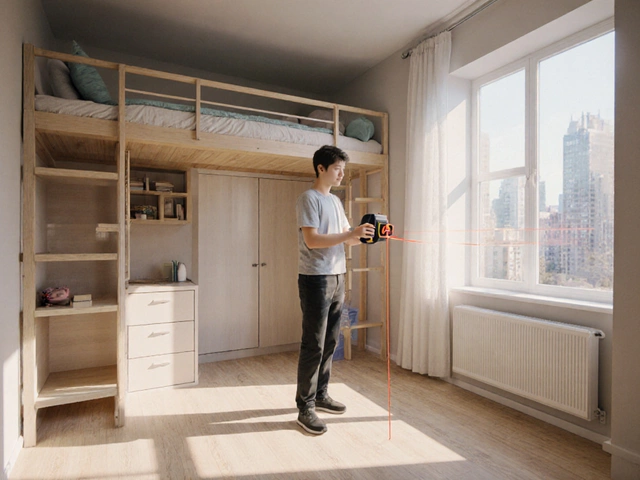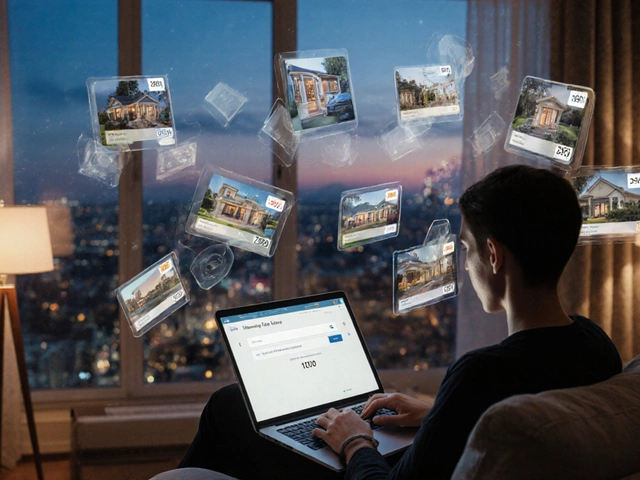Can You Invest in Real Estate Remotely? Your Guide to Buying Property Online

Real estate used to mean driving around neighborhoods with a realtor, opening a dozen front doors, and maybe getting lost a few times. Now, people buy properties in cities they’ve never visited—sometimes without leaving their sofa. Thanks to tech and mountains of data online, it’s easier than ever to become a landlord or property investor from miles away.
So how’s it possible? You can check out property tours on Zoom, sign contracts online, and even send a home inspector who live-streams the walkthrough to your phone. Sites like Zillow, Redfin, Roofstock, or Realtor.com offer listings with high-res photos, floor plans, and sometimes even 3D tours. If you’re not sure where to start, you’ll find tons of platforms that cater to remote investors.
Still, it’s not as easy as clicking "add to cart." There are real risks—think dishonest sellers, unreliable contractors, or hidden neighborhood problems. But with the right tools and a bit of street smarts, remote investing can work surprisingly well. My friend managed to grab a three-unit apartment in a college town he’d never visited—he hired a local property manager, set up smart locks, and tracked rent payments through an app. Five years later, he’s only been there once.
- How Remote Real Estate Investing Works
- The Best Tools & Platforms
- Risks and How to Avoid Them
- Building a Local Team from Afar
- Tips for Hands-Off Success
How Remote Real Estate Investing Works
Not so long ago, buying real estate from far away sounded nuts. Now, you can do it from your living room—even in your pajamas. At its core, remote real estate investing means finding, buying, and managing property in a different city or state without being there in person. It’s legit, scalable, and pretty common, especially since the pandemic forced everything online.
This all works thanks to a ton of digital tools and platforms. You can tour homes virtually, sign documents electronically, and organize repairs through local crews you’ve never met face-to-face. Remote deals used to be the playground of big investors, but today, even regular folks are getting in.
Remote real estate investing usually works like this:
- Use listing platforms (like Zillow, Redfin, Roofstock) to scout properties with virtual tours, data on local rent, and past sale prices.
- Research the neighborhood: Schools, crime, amenities—there’s data for everything these days.
- Hire a trusted local real estate agent who knows you’re not around and can handle things for you.
- Order third-party inspections and appraisals. Some inspectors offer walk-through videos or FaceTime calls.
- Handle all the paperwork through secure e-signature platforms—no printing or mailing needed.
- Use a local property manager to handle tenants, maintenance, and emergencies so you’re not woken up at 2 a.m. by a leaky faucet on the other side of the country.
If it sounds streamlined, that’s because it is. Freddie Mac found that in 2023, more than 15% of real estate investors bought properties without setting foot inside them.
"Today’s buyers can leverage tech tools to handle every part of the process remotely, from selecting a property to collecting rent—and that’s totally changed the game," says BiggerPockets co-founder Joshua Dorkin.
Check out how this stacks up with tried-and-true, in-person investing with this quick table:
| Step | Remote | Local |
|---|---|---|
| Finding Properties | Online platforms, virtual tours | Open houses, local agents |
| Property Analysis | Online data tools, remote video tours | Site visits, paper files |
| Paperwork | E-signatures, digital contracts | In-person signings, mail |
| Ongoing Management | Hire local pros, use management apps | DIY or local manager |
The bottom line: Technology has made buying property from anywhere pretty much as easy as shopping for a plane ticket—except with a little more paperwork and way more upside if you do your homework.
The Best Tools & Platforms
If you want to buy property online without setting foot inside, you’ll need to pick the right mix of tools and websites. Picking the best ones can seriously lower your risk and make the whole thing way less stressful.
Most remote real estate investors start with property listing platforms that give you trustworthy data and virtual tours. Zillow, Redfin, Realtor.com, and Roofstock lead the list. Roofstock in particular is built for remote buyers—they’ll let you buy homes already set up with a paying tenant and property manager, and they certify properties to avoid any nasty surprises.
For live virtual tours, Matterport 3D walkthroughs are the gold standard. You get a real sense of the space, which static photos just can’t provide. If you want to see what listings looked like over time, look up PropertyShark for public records, price history, and neighborhood data. Investors also use platforms like BiggerPockets to connect with other remote buyers and get help with deals.
Signing documents is all digital now. DocuSign and PandaDoc are widely used, so contracts fly back and forth instantly. For local due diligence, companies like Inspectify or AmeriSpec will do home inspections—and many stream the inspection to your phone. After closing, rental platforms like Buildium or AppFolio handle everything from collecting rent to dealing with leaky toilets…from your phone.
"The move to digital platforms is lowering the barrier to entry for all types of investors—whether you live 5 or 5,000 miles from the property," says John Burns, CEO of a respected real estate research firm.
Check out this quick look at the most popular online tools:
| Tool/Platform | Use | Main Perk |
|---|---|---|
| Zillow, Redfin | Property searches & comps | Loads of listings, up-to-date data |
| Roofstock | Remote investor marketplace | Pre-inspected rentals with tenants |
| Matterport | Virtual tours | 3D walkthroughs feel like you’re there |
| DocuSign | Digital contracts | Legally binding e-signatures |
| Buildium, AppFolio | Property management | Automates tenant and rent stuff |
Everyone has favorites, but don’t just pick the flashiest tool. Check user reviews, support, fees, and how easy it is to learn. If a platform connects you with reliable local pros, even better. These days, most things you need to run a remote property are just a click away.

Risks and How to Avoid Them
Diving into remote real estate investing feels exciting, but there’s a reason most folks tread carefully. The biggest risks aren’t always obvious—you can catch a lot with spreadsheets and video tours, but some problems love to hide just outside the camera frame.
Biggest worries? Getting scammed by a fake listing, property managers vanishing with your money, or buying in a falling neighborhood. A 2023 study by the National Association of Realtors found that scams around remote property deals spiked 12% over the last two years. Most stories that go wrong start with buyers trusting the wrong people or skipping regular checks on their asset.
- Scams and Fake Listings: If a deal seems way too good, slow down. Always double-check the property address across multiple sources. Real listings show up consistently.
- Property Condition Surprises: Nice photos can’t show a moldy basement. Hire a local home inspector who’ll give you a full report (and shoot you videos of the problem areas) before you even think of wiring money.
- Bad Local Team: The wrong property manager or agent can drain your profits. Interview three or more, ask for references, and check their reputation online—don’t just take the first name you get.
- Neighborhood Risks: Relying just on ZIP code is risky. Find crime stats and school ratings using free tools like Trulia or NeighborhoodScout. Rents and values depend on this stuff more than anything else.
What about money stuff? Wiring thousands to a stranger can make anyone nervous. Use escrow services (many digital marketplaces have them built in) so your cash is only released after the paperwork checks out.
| Common Remote Investing Risks | How to Protect Yourself |
|---|---|
| Fake Listings | Verify through county records and multiple sites |
| Hidden Property Damage | Order third-party inspections with full reports |
| Bad Team/Property Management | Check reviews, get references, use contracts with easy exit terms |
| Weak Rental Demand | Study local vacancy rates and job growth data |
| Wire Fraud | Send funds only through escrow to verified closing agents |
One more thing—set up regular check-ins. Some investors install smart cameras or hire local services just to wander by and send fresh photos every couple of months. It’s cheaper than discovering a burst pipe a year late.
Building a Local Team from Afar
When you invest from miles away, you’ll want boots on the ground you can trust. A good local team is the glue that holds your remote property together. But building that squad doesn’t have to be a guessing game—there are tested ways to do it, even if you’ve never stepped foot in the city.
First up is a property manager. Someone who knows the local rental market, can screen tenants, and arrange repairs is just non-negotiable. They should be licensed and have legit reviews, not just a nice website. You can vet them through sites like BiggerPockets, Google reviews, or referrals from Facebook landlord groups. Always ask for references and check how long they've managed properties in that ZIP code.
Don’t forget about your contractor or handyman. Get three estimates for every job, and never pay the whole balance up front. Video calls are your friend—ask them to walk you through the work live. Some investors swear by sending a lockbox code so workers can get in without scheduling drama.
Need more help? An agent who specializes in remote real estate investing is worth their weight in gold. Some will even walk a property with you on video, pointing out anything from weird basement smells to cracks in the driveway.
Here’s a quick rundown of the core team and where to find them:
- Property Manager: NARPM.org, Yelp, local Facebook groups
- Contractor/Handyman: Angi (former Angie’s List), HomeAdvisor, trusted from your property manager’s roster
- Real Estate Agent: BiggerPockets forums, Zillow “Find an Agent” tool, references from local investors
- Home Inspector: ASHI.org, local inspection companies, word-of-mouth from your agent
- Cleaner/Lawn Care: Thumbtack, Craigslist, recommendations from your manager
Worried about cost? Paying pros on site usually saves you cash long-term by catching problems early. Check out these average monthly costs for remote investors in 2024, compared to old-school DIY landlords:
| Role | Typical Fee (Monthly) | Worth the Investment? |
|---|---|---|
| Property Manager | 8-10% of rent | Yes, smoother operations and fewer headaches |
| Handyman/Contractor (routine) | $100-300 (as needed) | Yes, faster repairs = happy tenants |
| Agent (acquisition, one-time) | 3% of property price (included in sale) | Unless you’re buying direct, crucial for the hunt |
| Home Inspector (one-time) | $400-700 | Absolutely, catches dealbreakers |
To keep everyone on track, set up simple group texts, WhatsApp chats, or even project management tools like Trello. The goal is fast, clear updates on repairs or rent. If your team is responsive and communicates well, you’ll sleep a lot easier—no matter how far away you are.

Tips for Hands-Off Success
Managing a property from miles away only works if you’ve got a smart system in place. The goal? Make things run smoothly without traveling to fix minor issues or chase down tenants for late rent. Here’s what separates the hassle-free remote investors from the stressed-out ones.
- Remote real estate investing starts with picking a reliable property manager. Check reviews, ask for references, and interview at least three companies. The right manager acts like your eyes and ears, handling rent collection, repairs, and tenant screening.
- Automate payments and tracking. Services like AppFolio, Buildium, and Cozy let you pay vendors, receive rent, and monitor accounts—all in one dashboard. The less you handle by hand, the fewer things will fall through the cracks.
- Invest in smart locks or keyless entry systems. Products like August, Kwikset, and Schlage make it easy for managers or maintenance crews to get in fast. Plus, you won’t have to mail keys or deal with lockouts.
- Have a solid process for repairs. Require your manager to get a second quote for any repair over a certain amount (say, $500). Get photos or videos before and after the fix. This keeps your costs down and headaches low.
- Stay organized with cloud storage. Use Google Drive or Dropbox to store all your contracts, inspection reports, and receipts. If you ever need something fast (like during tax time), it’s right there.
One of the biggest risks for remote landlords is missing small issues that turn into big problems. Consider setting up twice yearly virtual inspections. Your manager or an inspector can FaceTime you while they walk through the property, showing you in real-time if anything looks off.
Need some numbers? This table shows platform popularity among remote landlords as of early 2025:
| Platform | Primary Use | % of Remote Landlords Using |
|---|---|---|
| Buildium | Payment, tenant management | 35% |
| AppFolio | Full property management | 29% |
| Cozy | Payments, applications | 18% |
| Google Drive | Document storage | 31% |
| Smart Locks | Remote access/security | 44% |
Tech takes you far, but don’t forget the human element. Call your property manager regularly. Check neighborhood forums or Facebook groups for local news. Simple routines like these keep your investment running on autopilot—and leave you more time for the stuff you actually want to do.









Write a comment